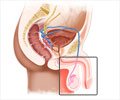The new crucial test carries the risk of false positives (which could lead to discarding a normal embryo) and false negatives (which could lead to transferring an embryo with a chromosomal abnormality).

‘Test that sequences released DNA may improve selection of embryos for clinical in vitro fertilization’





To determine the quality and viability of an embryo, embryologists typically examine specific features of the embryos using a light microscope. In addition, specialists can use data from preimplantation genetic testing for aneuploidy (PGT-A), a test of whether cells from the embryo at the blastocyst stage have a normal or abnormal number of chromosomes. However, this crucial test carries the risk of false positives (which could lead to discarding a normal embryo) and false negatives (which could lead to transferring an embryo with a chromosomal abnormality).
A team of researchers from Brigham and Women's Hospital, in collaboration with colleagues at Peking University and Yikon Genomics in China, have evaluated a new way to conduct preimplantation genetic testing and present results showing that this new method may improve the reliability of the test. Their findings are published in Proceedings of the National Academy of Sciences.
"This technique holds the promise of a more precise test than the current method," said co-corresponding author Catherine Racowsky, PhD, director of the IVF laboratory at the Brigham, and professor in the Department of Obstetrics and Gynecology at Harvard Medical School. "It represents a new way to evaluate embryos with less risk of discarding a viable embryo."
Current PGT-A testing uses a trophectoderm (TE) biopsy. If the blastocyst was a tennis ball, then its fluffy, green outer covering would be its TE cells. Inside the blastocyst is the inner cell mass (ICM) -- cells that will give rise to the fetus. Since current PGT-A testing involves biopsy of a few TE cells, they sometimes fail to reflect the genomic profile of the ICM cells within, especially if the blastocyst contains both normal and abnormal cells -- a phenomenon known as mosaicism.
Advertisement
The team tested the accuracy of niPGT-A using 52 blastocysts donated for research by patients undergoing infertility treatment. Each blastocyst had previously undergone TE biopsy testing by an outside laboratory. The investigators compared the sequencing results of DNA from both the surrounding culture medium and TE biopsy samples with the true results obtained by sequencing the whole embryo.
Advertisement
The team notes that the sample size they used was small and that a higher percentage of the embryos were abnormal than would be traditionally seen from women of comparable age in an IVF clinic. The embryos had also been previously biopsied, frozen and then thawed, potentially increasing the amount of DNA leakage from the inner cell mass into the medium. The team is already at work on follow-up experiments to validate that DNA can be detected in the medium, even in embryos that have not been previously biopsied.
"Our ongoing work will help us to determine whether niPGT-A will translate into a paradigm shift for PGT-A in clinical IVF," said Racowsky.
Source-Eurekalert















